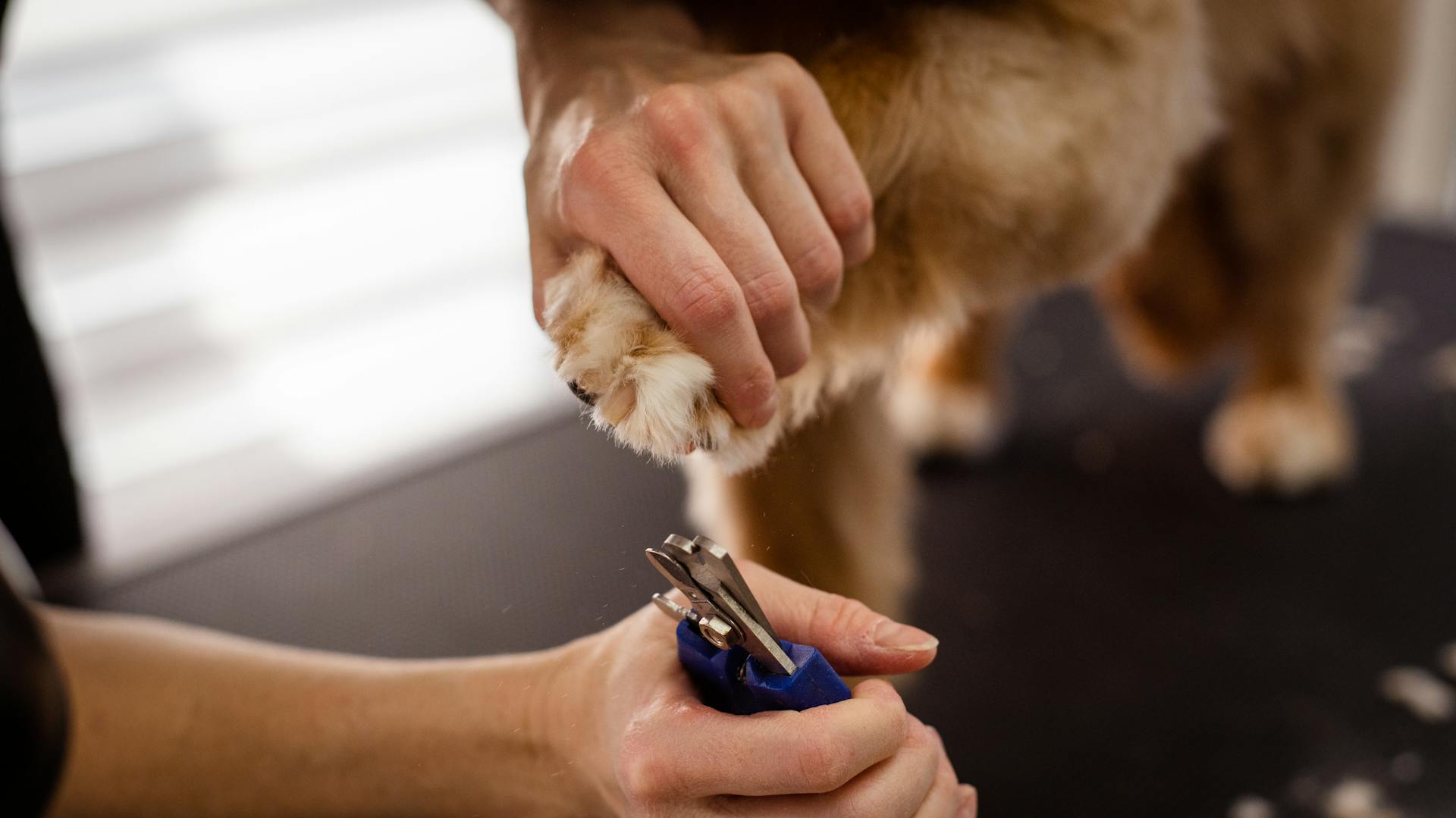
Samoyeds are a loyal and loving breed that thrive on interaction and attention. They were originally bred to herd reindeer and other animals in Siberia.
To keep your Samoyed happy and healthy, regular exercise is essential. A daily walk of at least 30 minutes is recommended, but they also love to run and play off-leash.
Samoyeds have a thick double coat that sheds heavily, so regular grooming is a must. Brushing their coat 2-3 times a week can help reduce shedding and prevent matting.
Samoyeds are intelligent and trainable, but they can be stubborn at times. Consistent and positive reinforcement training is key to developing good behavior.
General Appearance
The Samoyed's general appearance is a sight to behold. Their wedge-shaped head is proportional to their body size, forming a medium-length wedge when viewed from the front.
Their ears are strong, thick, and triangular, rounded at the tips, and carried erect. Samoyeds have almond-shaped eyes that are deep and dark, placed well apart, and framed by dark eye rims.
Expand your knowledge: Dark Border Terrier
Their nose is usually black, but can be dark brown, and may change color with age and weather. The breed's distinctive facial features include a "mask" of lighter shading around their forehead, cheeks, and muzzle, which makes their dark eyes and nose stand out.
Samoyeds have a double coat, consisting of a soft, thick undercoat and a longer, coarser outer coat that stands straight out from their body. Their tail is moderately long, covered with thick hair, and should be set neither high nor low.
Here are the key characteristics of a Samoyed's general appearance:
- Wedge-shaped head
- Strong, thick, and triangular ears
- Deep and dark almond-shaped eyes
- Black or dark brown nose
- Double coat with soft undercoat and longer outer coat
- Moderately long tail with thick hair
Their body is slightly longer than tall, with legs that are somewhat long and moderately well-boned. Males tend to have a heavier "ruff" on their neck, while females may be slightly longer in body.
Temperament
Samoyeds are known for their friendly and outgoing personalities, always ready to make new friends and be the center of attention.
Their good-natured temperament makes them a great addition to any family, but not ideal as guard dogs - they're likely to welcome intruders with a tour of the house.
Samoyeds are whip-smart and crave attention and affection, which means they can become mischievous if left to their own devices.
They form deep bonds with their human families and have a pack mentality, which is why proper socialization is crucial to keep them active, engaged, and challenged.
Samoyeds are naturally headstrong and demanding, and will let you know when they need attention with their distinctive whine.
They're also prone to barking or using their teeth to get your attention, especially if they're not fully trained - but this behavior is just a natural extension of their pack behavior.
Their dense fur makes them grip harder, which is why they might nip or tug at you with their teeth in a non-aggressive manner.
Readers also liked: Female Dog Humps Male Dog
Care and Grooming
Samoyeds are high-maintenance dogs that require regular grooming to maintain their beautiful, wool-like coat.
Their double coat sheds year-round, but twice a year, during the spring and fall seasons, they will shed more than usual, a process known as blowing coat.
Daily brushing is essential during these periods to prevent painful mats and hot spots from forming, and to keep your home clean from all the loose hair.
A long hair de-shedding tool and a metal dog comb can be helpful tools for removing dirt and loose hairs and preventing mats.
Brushing your Samoyed's teeth at an early age and working your way up to daily brushing is crucial for keeping their teeth healthy and preventing periodontal disease.
Trim their nails every three to four weeks, and check their ears regularly for any signs of redness or a bad odor, which could be signs of an ear infection.
To acclimate your Samoyed to their grooming routine, be patient and reward them repeatedly, and introduce them to each item at an early age to make the process less stressful.
Samoyeds require a nutritious diet, and the type and amount of food they need can be determined by their age, size, and activity level.
Daily exercise is also essential for Samoyeds, who are innately hard-working and energetic, and they need one or two moderate walks a day, or a play session in or outdoors.
Explore further: What Nutrients Do Dogs Need in Homemade Dog Food
It's essential to not over-exercise your Samoyed, especially during their growth spurt, as heavy exercise can put stress on their developing bones and joints.
Regular grooming sessions with a professional groomer can be beneficial, especially during peak shedding seasons, to ensure that their baths and brushings are done thoroughly.
Samoyeds need to be bathed at least twice a year, and more frequently if they're active, and it's essential to dry their coat thoroughly after bathing to prevent skin problems.
By following these grooming and care tips, you can help keep your Samoyed happy and healthy, and enjoy the many benefits of owning this wonderful breed.
Health and Nutrition
Samoyeds are generally a healthy breed with long lifespans of 12 to 14 years, but like any dog, they can be prone to certain health issues. Cataracts, a cloudiness in the pupil, eye inflammation, and squinting are all symptoms of cataracts in Samoyeds, and surgery may be required to prevent blindness.
Progressive Retinal Atrophy (PRA) is another inherited disease that can cause a dog to slowly go blind over time. It's essential to have genetic screening testing done to determine if your Samoyed is at risk.
Samoyeds also need to be watched for signs of weight gain, as they can suffer from elbow and hip dysplasia, where the joints aren't formed properly. Treatments range from weight management to physical therapy to surgery, depending on the severity.
A healthy diet is crucial for Samoyeds, and they should be fed high-quality commercial or home-cooked dog food twice per day. It's also essential to keep an eye on their calorie intake and weight, as treats can quickly add up and contribute to weight gain.
Here are some common health issues in Samoyeds:
- Cataracts: cloudiness in the pupil, eye inflammation, squinting
- Progressive Retinal Atrophy (PRA): slow loss of vision
- Elbow and Hip Dysplasia: abnormal gait, stiffness in joints
- Cardiac Disorder: difficulty breathing, collapsing
- Hypothyroidism: hair loss, weight gain, lethargy
- Samoyed Hereditary Glomerulopathy: kidney failure
Teeth
The Samoyed's dental health is quite impressive, with a complete set of evenly spaced, white teeth. A scissors bite is the ideal alignment for their teeth, which is a result of their breeding history.
Related reading: Dog Food for Dogs with No Teeth
Having a scissors bite means that the upper teeth overlap the lower teeth slightly, which helps with their overall dental health. This is a desirable trait in the Samoyed breed.
Undershot or overshot teeth are considered faults in the Samoyed breed, indicating a deviation from the ideal scissors bite. This can lead to problems with their dental health and overall well-being.
Readers also liked: Dog Bite
Common Health Problems
Samoyeds are generally a healthy breed, but like all dogs, they can be prone to certain health issues. Cataracts and Progressive Retinal Atrophy (PRA) are two common eye problems that can affect Samoyeds, causing cloudiness in the pupil, eye inflammation, and even blindness.
Progressive Retinal Atrophy is an inherited disease that can lead to blindness over time, but dogs often adjust to vision loss and lead happy lives. Genetic screening testing is available to identify the condition early on.
Elbow and hip dysplasia can also affect Samoyeds, causing joint pain and stiffness. Responsible breeders will test their dogs for these conditions to ensure they are not passing them on to their puppies.
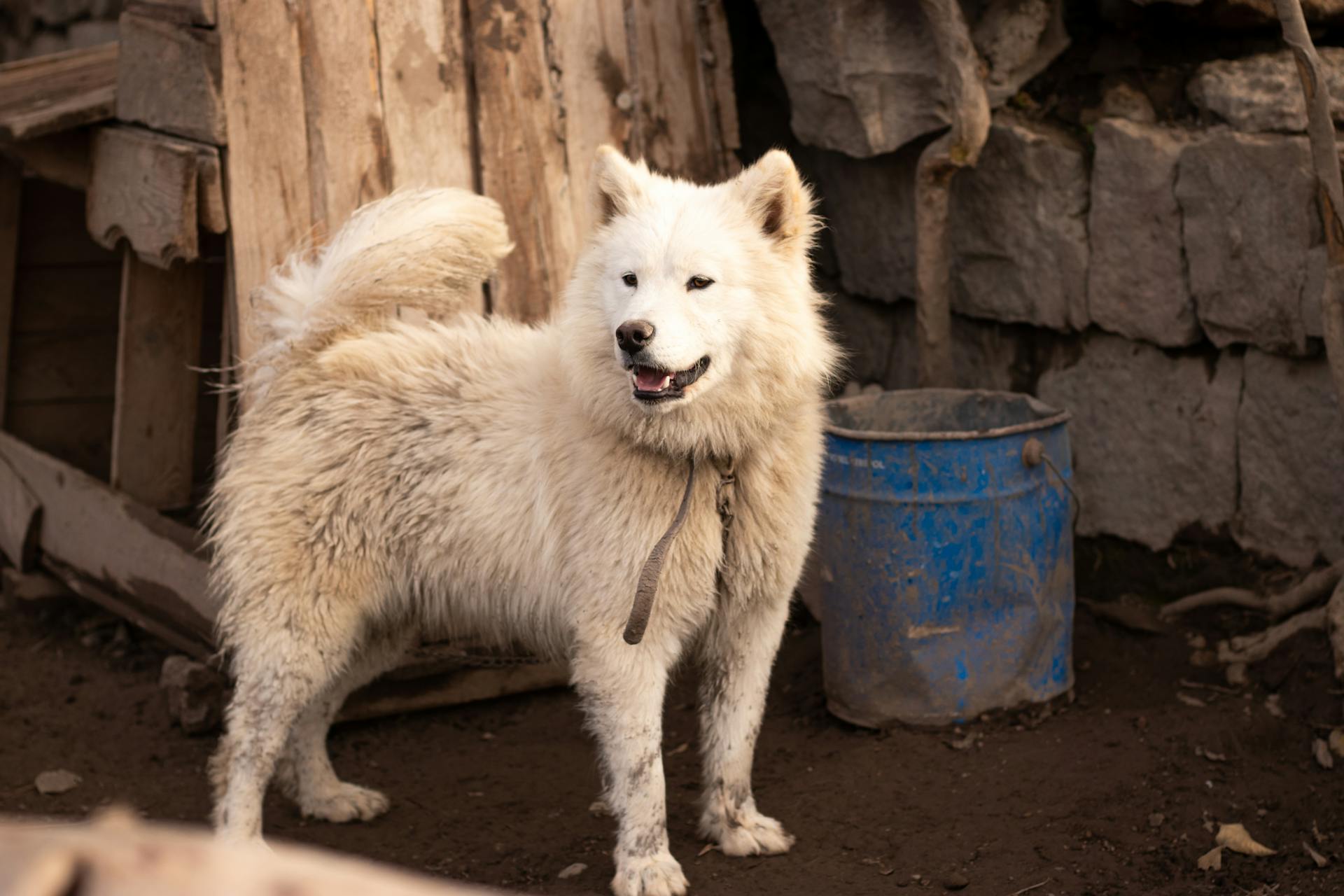
Here are some common health issues that can affect Samoyeds, along with their symptoms:
- Glaucoma: painful pressure buildup in the eyes, leading to blindness
- Progressive Retinal Atrophy (PRA): blindness over time, with genetic screening available
- Hip Dysplasia: joint pain and stiffness, with surgery possible for severe cases
- Samoyed Hereditary Glomerulopathy: genetic kidney disease causing toxin buildup in the blood
- Diabetes Mellitus: pancreas failure to regulate blood pressure
- Hypothyroidism: underactive thyroid gland, affecting hormone production
- Subvalvular Aortic Stenosis: heart obstruction or blockage
Digestive issues, lameness, arthritis, allergies, and ear infections are also common health problems that can affect Samoyeds. Regular veterinary check-ups can help identify these issues early on and prevent more serious problems from developing.
Suggestion: Pembroke Welsh Corgi Health
Diet and Nutrition
Samoyeds need to be fed high-quality dog food twice a day to stay healthy.
Their portions should be limited to prevent weight gain, so keep an eye on their weight and adjust their meals accordingly.
Fresh water should be available at all times to keep them hydrated.
Talk to your veterinarian to determine a healthy diet plan for your Samoyed based on its age, weight, and activity level.
A high-quality dog food designed for their age is essential, whether they're a puppy, adult, or senior.
Treats can contribute to weight gain, so be mindful of their calorie intake.
Check with your vet if you have any questions about mealtime, as they can help you choose the right food and portions for your pup.
Suggestion: Is High Protein Dog Food Good for Dogs
Training and Socialization
Training a Samoyed should be relatively simple once the basics are done, as these dogs form strong bonds with their humans and aim to please. However, this breed is known for having a stubborn streak at times.
Start training your Samoyed as early as possible, ideally when they're seven to eight weeks old. Basic obedience skills like sit, stay, and come are critical to helping your pup know how to be a well-behaved member of the family.
Sammies are intelligent and ambitious, so they are often eager to learn, but they don't always want to listen. Keep training sessions short and reward your friend with treats, toys, and praise to keep them engaged.
Socialization and Training: Keys to Success
Socialization and training are crucial for Samoyeds to become well-adjusted companions.
Start training your Samoyed as early as possible, ideally from seven to eight weeks old, to establish a strong foundation for their development.
Training sessions should be short and fun to keep your dog's attention, and be sure to reward them with treats, toys, and praise.
Socialization should also begin early, introducing your puppy to different environments, noises, people, and experiences in a positive and rewarding way.
This helps build confidence and prevents shyness or reactivity later on, making your Samoyed a well-rounded and friendly companion.
Structured training classes are highly recommended for Sammies, as they thrive on having constructive jobs, challenges, and boundaries to channel their boundless energy productively.
Positive reinforcement techniques keep them engaged through reward-based lessons focusing on polite manners and obedience, building a healthy bond and trust between dog and owner.
By following these guidelines, you'll be well on your way to raising a well-behaved and socialized Samoyed that will bring joy and companionship to your life.
Exercise Needs
Samoyeds need a lot of exercise to stay happy and healthy, with at least two hours of activity per day.
They're built for endurance, bred from hard-working sled dogs that could trot for miles in harsh Arctic conditions. Daily walks or hikes are a must, but quick walks around the block just won't cut it - plan for at least an hour of good exercise each day.
These dogs thrive with activities that allow them to use their inherited skills and work toward a goal, like weight pulling competitions, agility courses, or fly ball. They're also great at dog sports, so if you're into competition, try agility or obedience.
Samoyeds can get up to speeds over 30 MPH, but they're happy to jog at a more leisurely pace alongside you. They're true attention seekers, which means they're not always crazy about sharing the limelight with other pets or people.
In warmer weather, be mindful of their thick coats and plan walks and outdoor activities in the early morning or late evening when it's cooler. They may not like sharing the spotlight, but they're not territorial - they just want to play with everyone around them.
Suggestion: Pembroke Welsh Corgi Agility
History and Origins
The Samoyed breed has a rich history that spans centuries, originating from the semi-nomadic Samoyede people of Siberia. They were bred to work and thrive in the harsh Arctic environment, where temperatures can drop to minus 60 degrees Fahrenheit.
Their thick, white coats kept them warm and protected, making them ideal for herding reindeer and pulling sleds across the Arctic tundra. Samoyeds were also used as watchdogs and companions, forming close bonds with their owners.
The Samoyed breed was introduced to England in the late 18th century by Arctic explorers, who were impressed by their regal coats and friendly nature. Queen Alexandra, the future Queen of the United Kingdom, fell in love with the breed and promoted it as a companion and show dog.
A different take: Queen Victoria Pomeranian Dog
History of
The Samoyed breed has a rich history that spans centuries, originating from the semi-nomadic Samoyedic people of Siberia.
Their name comes from the Samoyede people, who relied on the breed for activities like hunting, herding reindeer, and pulling sleds. These dogs were used to haul heavy loads for long distances across the Arctic tundra.
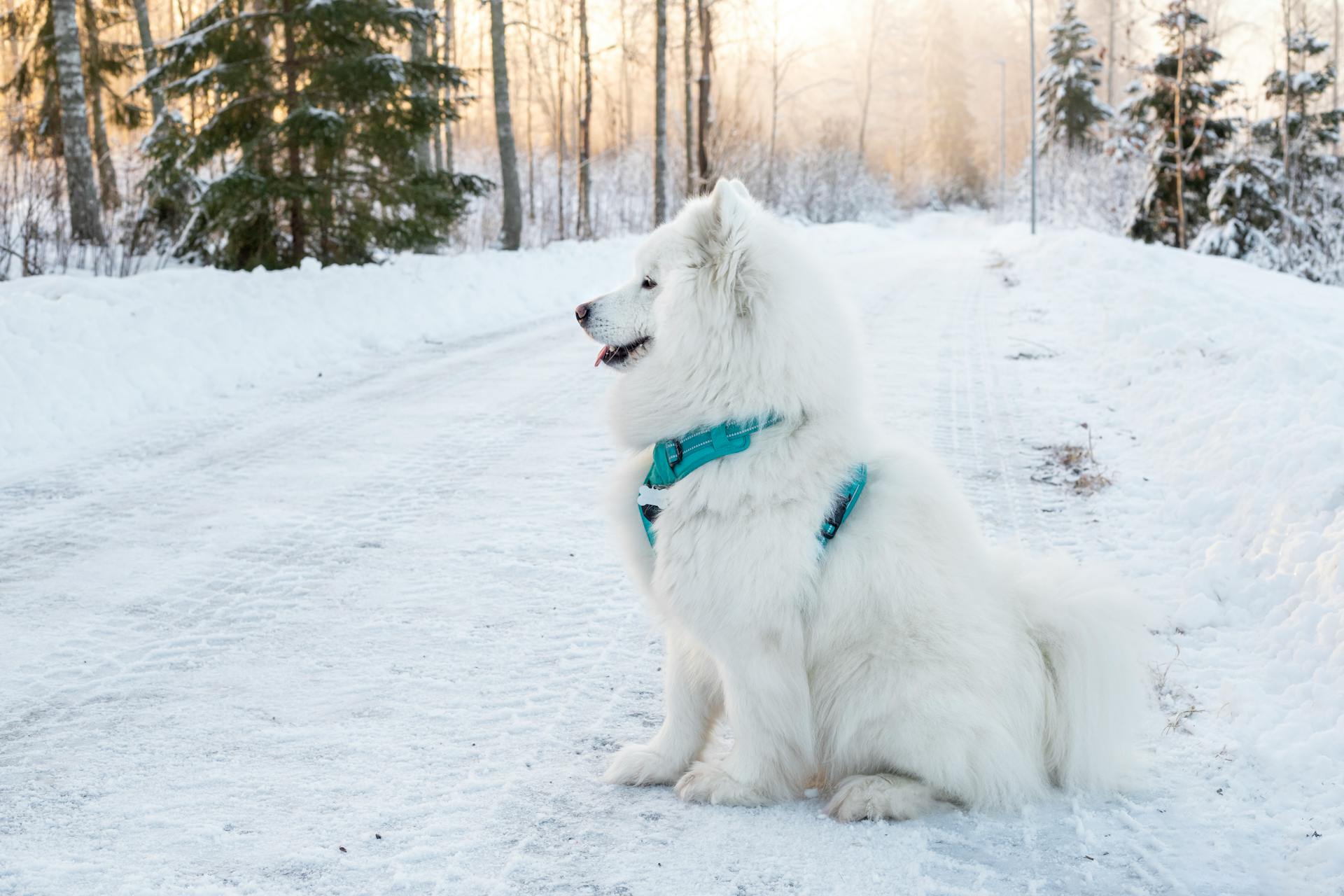
The Samoyed's thick white coat is its defining trait, keeping it warm and protected in frigid temperatures that can drop to minus 60 degrees Fahrenheit. This coat is a testament to the breed's ability to thrive in harsh environments.
The breed was originally bred to be a working dog, but it also formed a close bond with its human family, often sleeping in their beds to keep them warm. This close relationship developed a trusting, loyal, and friendly personality in the breed.
Arctic explorers introduced the Samoyed to British dog lovers in the late 18th century, and Queen Alexandra fell in love with the breed, promoting it as a companion and show dog. The breed continued to pull sleds in Arctic and Antarctic expeditions in the late 19th and early 20th centuries.
The American Kennel Club registered the first Samoyed in 1906, and the breed has since become a popular companion dog. However, training a Samoyed can be challenging, especially for first-time dog parents.
The Samoyed's strong work ethic and friendly nature have made it a great companion to humans throughout its existence. The breed's popularity has increased exponentially since World War II, and it remains a common breed in the U.S. and many other countries worldwide.
Check this out: Arctic Alaskan Malamute
Embracing Diversity
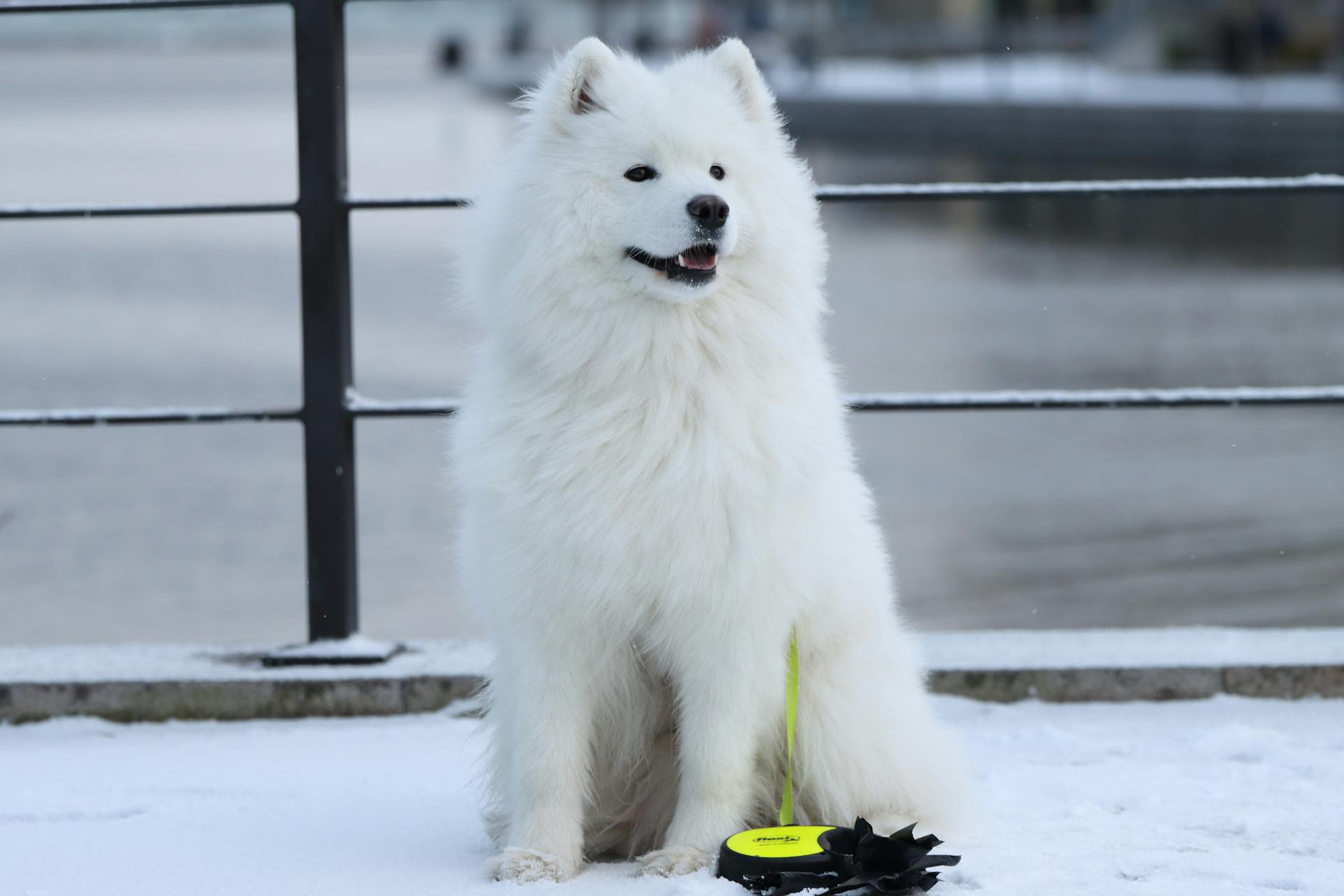
The Samoyed's rich history is a testament to their incredible diversity. Throughout the 20th century, breed clubs in England, America, and beyond worked to standardize the ideal Samoyed size, appearance, and conformation.
This preservation of the Samoyed's working heritage genes is what gives them such a beautifully balanced demeanor today. Their versatility as capable working retrievers, pullers, and herders made them beloved dogs for various tasks, from estate guardians to couriers, sled dogs, and performers.
Their people-oriented sledding roles have contributed to their gentle nature, making them perfect family companions. As a result, Sammies have become an endless fountain of amusement for many families.
Size and Stature
Samoyeds are quite compact and portable for their ample fluffiness, making them a great choice for families with kids, apartments, or homes without huge yards.
Adult male Samoyeds stand around 21-24 inches tall at the shoulder and weigh 45-65 lbs, while the ladies are just a tad smaller, standing 19-21 inches and weighing 35-50 lbs.
Their medium-ish size, combined with their friendly demeanors, makes them perfect for owners who enjoy bringing their pups along on adventures.
Forequarters
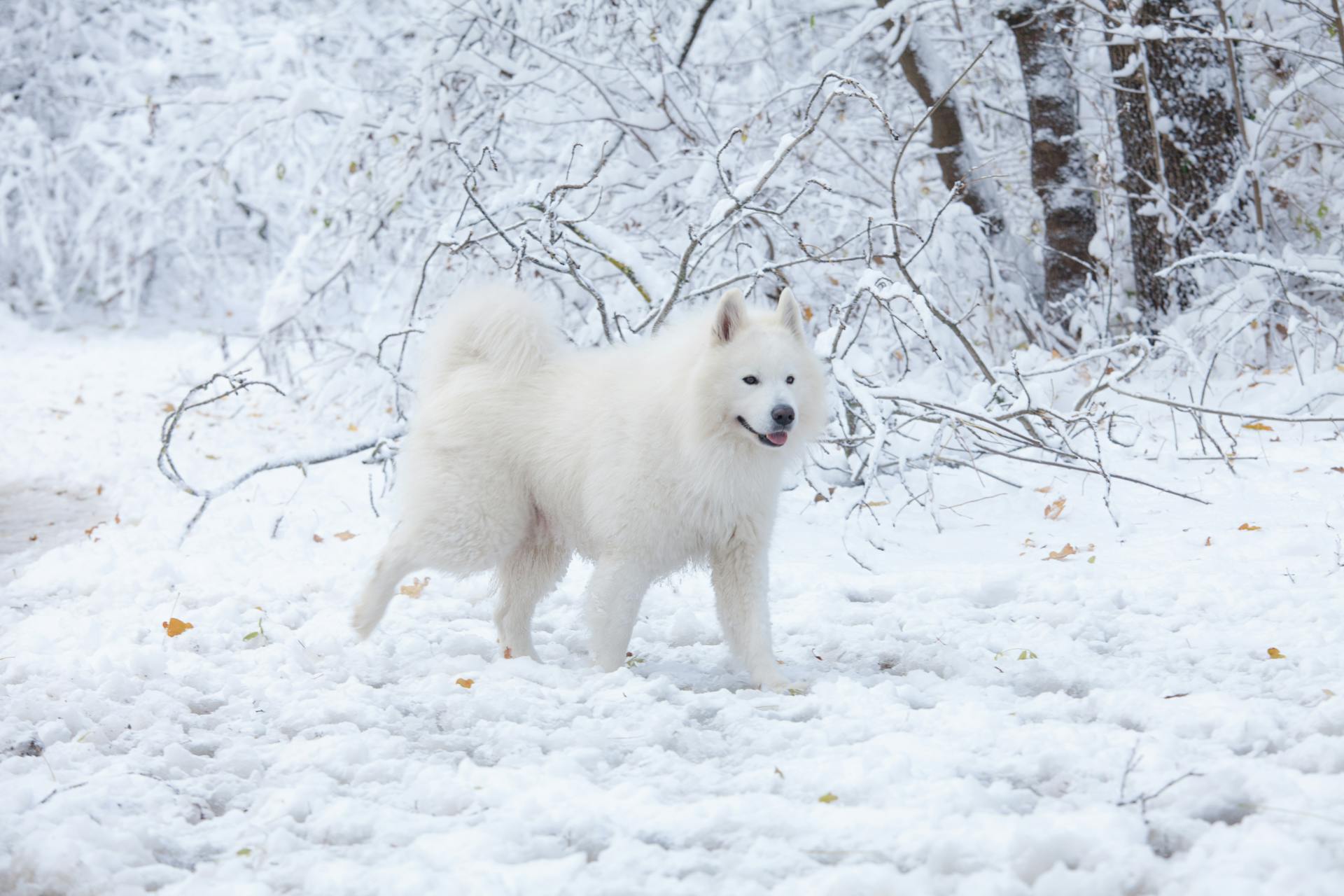
The forequarters of a dog are a crucial aspect of its overall structure, and there are some specific characteristics that breeders and owners should look out for.
The shoulders are long and well laid back, with good angulation and well-developed muscles. This is important for a dog's movement and flexibility.
The shoulder blade and the upper arm are roughly equal in length, which helps to create a balanced and proportionate look. This balance is key to a dog's overall appearance and functionality.
The upper arm lies close to the ribs with the elbow moving close to the body, which allows for a smooth and efficient gait. This is especially important for dogs that will be used for work or exercise.
Forelegs are moderately well boned, straight and muscular, with moderately short, moderately sloping, flexible pasterns. This type of pastern is essential for a dog's ability to move and change direction quickly.
Suggestion: What Does a Pomeranian Dog Look like
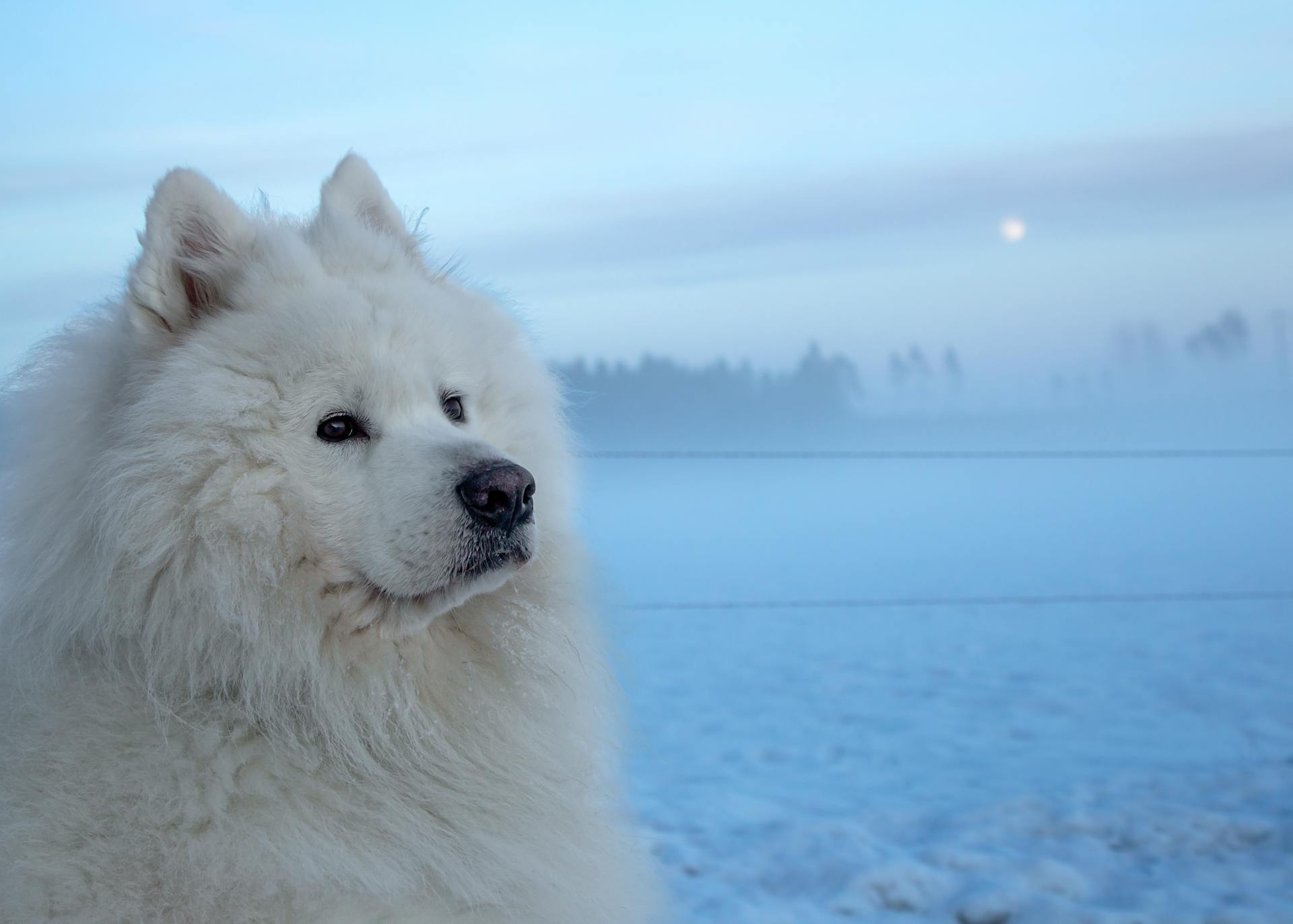
The length of leg from elbow to ground should be approximately 55 percent of the dog's height at the withers. This is a key measurement that breeders and owners should take into account when evaluating a dog's size and stature.
The space between the tips of the shoulder blades is approximately 1 to 1½ inches. This is a small but important detail that can make a big difference in a dog's overall appearance.
A fresh viewpoint: Will Shiba Inu Hit 1 Cent
Size and Stature
Samoyeds are a compact breed, with adult males standing around 21-24 inches tall and weighing 45-65 lbs.
Their smaller size makes them a great choice for families with kids, apartments, or homes without huge yards.
Male Samoyeds typically weigh between 50-65 pounds and females between 35-50 pounds.
Samoyeds are not too heavy, but rather have a bone structure that's heavier than expected for their size.
Their weight should be in proportion to their height, and they should never appear clumsy or racy.
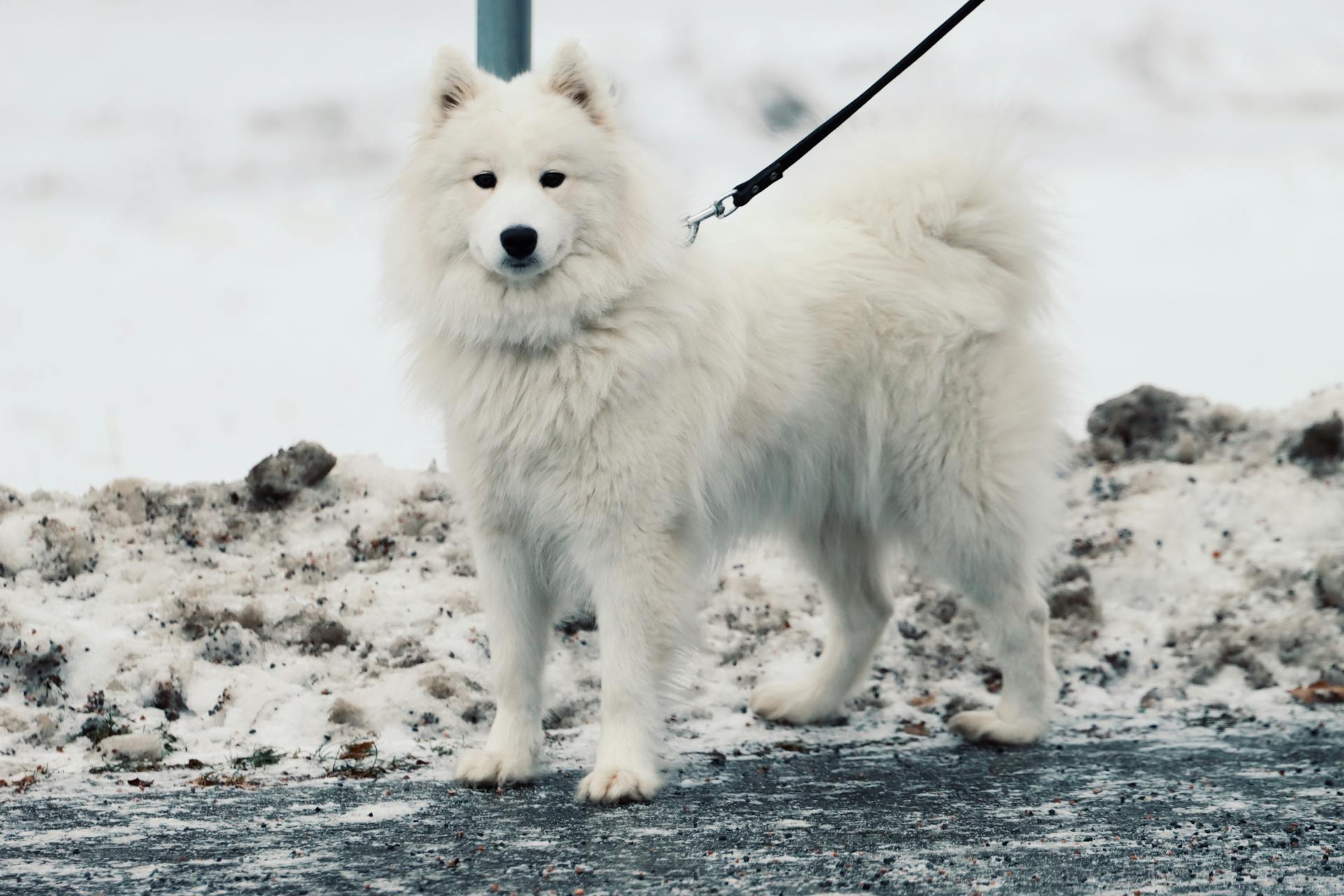
On average, Sammies stand around 19-23 inches tall, with males being slightly taller than females.
The ladies are just a tad smaller, standing 19-21 inches tall and weighing 35-50 lbs.
Their friendly demeanors and medium size make them a great choice for families and owners who enjoy bringing their pups along on adventures.
Gait
A Samoyed's gait is a vital aspect of its overall movement and should be effortless, smooth, and powerful. The gait should show good reach in front and drive behind.
The back remains level, with only a slight flexing to indicate suppleness.
Legs should turn neither in nor out, nor should feet cross or interfere with each other.
As speed increases, feet tend to converge toward the centerline of balance.
Lifestyle and Companionship
Samoyeds thrive on having regular jobs and activities to do, making them perfect companions for active families who love spending time outdoors.
They're well-equipped to be rugged outdoor adventure buddies, with thick double coats that keep them well-insulated and protected in snow, and hard-working heritage that gives them incredible stamina for hiking, camping, and more.
Their natural ability to settle in just about anywhere comfortably and calmly, thanks to their clean habits, easygoing temperaments, and fierce loyalty to their human pack, makes them fantastic road trip or camping companions.
Samoyeds have an unshakable loyalty and devotion to their human "packs" as companions first and foremost, living to be by our sides through every up and down.
Responsible Ownership
Owning a Samoyed is a big responsibility, and it's essential to meet their substantial exercise needs daily. They require ample physical and mental stimulation to prevent boredom, lack of exercise, and improper training.
If their needs aren't met, Samoyeds can get into serious trouble, manifesting as nuisance barking, destructive behaviors, and anxiety issues. Regular brushing is crucial to control excessive shedding.
Samoyeds have a devout following and passionate breed clubs worldwide, offering fantastic educational resources, grooming tips, and connections to trusted breeders. Getting involved with your local or national Samoyed organization can be a great way to learn and connect with other owners.
With their substantial grooming needs, Samoyeds shouldn't be allowed free access to roam and shed indiscriminately in shared community spaces. This can be a nuisance to others and requires responsible ownership.
Adventure and Workout Partners
Samoyeds are natural-born adventurers, bred to withstand the harsh Siberian Arctic and thrive in rugged outdoor environments. Their thick double coats keep them warm and protected in snow, while their hard-working heritage gives them incredible stamina for hiking, camping, and winter sports.
Whether you're hitting the trails, hiking, or engaging in other outdoor activities, a Samoyed is the perfect companion. They love to join in on the fun and will keep you motivated and energized throughout the journey.
Samoyeds have an innate ability to settle in just about anywhere comfortably and calmly, thanks to their naturally clean habits, easygoing temperaments, and fierce loyalty to their human pack. This makes them fantastic road trip or camping companions, as long as they can be by your side.
With their impressive endurance, enthusiasm for any activity, and innate warmth, Samoyeds are born to be our brave, tireless trail buddies. They'll keep up with you every step of the way, whether you're exploring new cities on urban treks or camping out under the stars.
Their love for adventure is contagious, and having a Samoyed by your side will make every outing a memorable one. So why not grab your gear and hit the trails with your new furry friend?
For another approach, see: Lancashire Heeler News
Adopt/Buy
Adopting a Samoyed can be a bit challenging, but it's definitely worth it. If you're interested in adopting a Samoyed, check with breed-specific rescues or visit your local shelter to meet a similar dog in need of a forever home.
Samoyeds aren't especially rare, but they may be harder to find in shelters than other breeds. If you're planning to adopt a Samoyed puppy, it's essential to research responsible breeders.
These breeders should be willing to let you meet the litter's parents, see the conditions the dogs are kept in, and provide their family medical history. You should also expect to pay between $600 and $1,500 for a puppy, but prices may be closer to $3,000 depending on pedigree and availability.
Here are some resources to help you start your search:
- Samoyed Club of America
- Samoyed Club of America Rescue Groups
- AKC Samoyed Breeders
These groups will be able to provide guidance about Samoyed adoption, and may even refer you to a local branch or rescue.
Frequently Asked Questions
Is a Samoyed a good house dog?
Yes, Samoyeds are well-suited as house dogs due to their friendly and patient nature. They thrive on family interaction, making them a great fit for active households.
Are Samoyed dogs expensive?
Samoyed dogs can be costly to purchase and maintain, with initial prices ranging from $4,000 to $8,000 and annual expenses of $1,500 to $2,500. However, with proper care and attention, owning a Samoyed can be a rewarding and loving experience.
Is Samoyed a husky?
No, Samoyeds and huskies are distinct breeds, although they share some similarities due to their shared origins in Russia's northwestern region. While they both have thick coats and have been used for sled pulling, they have unique characteristics and histories.
Do Samoyed dogs shed a lot?
Samoyeds shed heavily at a constant rate and experience a significant coat blow twice a year, resulting in excessive hair loss. If you're considering a Samoyed, be prepared for regular grooming and potential hair accumulation.
Do Samoyed dogs bark a lot?
Samoyeds can bark, but with proper training, excessive barking can be discouraged. Training can help minimize barking in Samoyed dogs.
Featured Images: pexels.com


